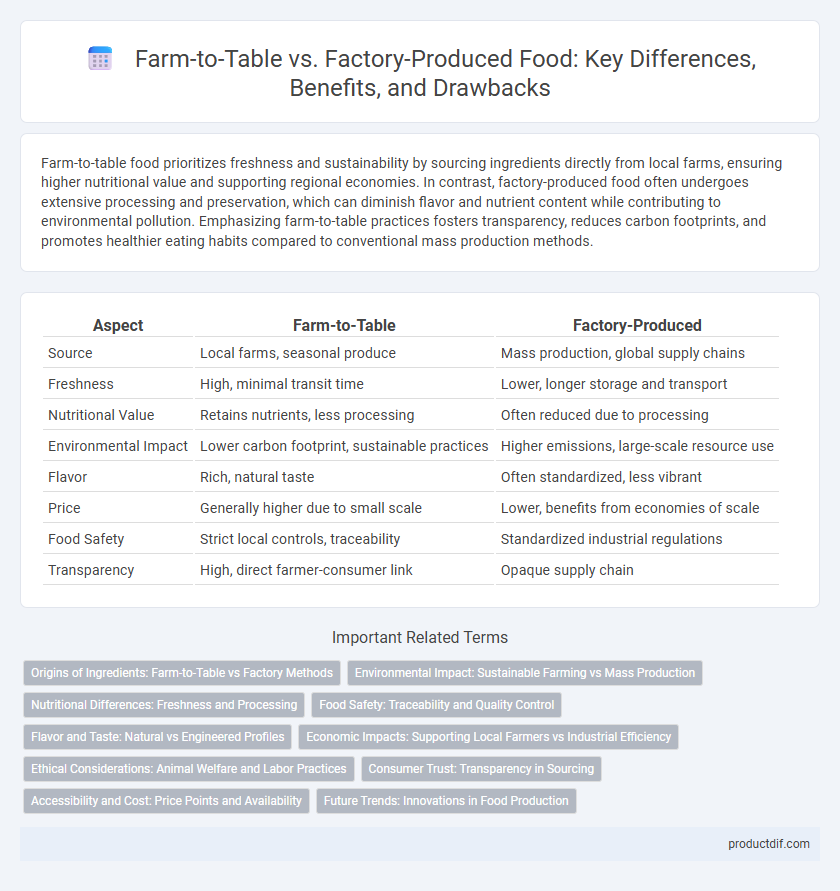Farm-to-table food prioritizes freshness and sustainability by sourcing ingredients directly from local farms, ensuring higher nutritional value and supporting regional economies. In contrast, factory-produced food often undergoes extensive processing and preservation, which can diminish flavor and nutrient content while contributing to environmental pollution. Emphasizing farm-to-table practices fosters transparency, reduces carbon footprints, and promotes healthier eating habits compared to conventional mass production methods.
Table of Comparison
| Aspect | Farm-to-Table | Factory-Produced |
|---|---|---|
| Source | Local farms, seasonal produce | Mass production, global supply chains |
| Freshness | High, minimal transit time | Lower, longer storage and transport |
| Nutritional Value | Retains nutrients, less processing | Often reduced due to processing |
| Environmental Impact | Lower carbon footprint, sustainable practices | Higher emissions, large-scale resource use |
| Flavor | Rich, natural taste | Often standardized, less vibrant |
| Price | Generally higher due to small scale | Lower, benefits from economies of scale |
| Food Safety | Strict local controls, traceability | Standardized industrial regulations |
| Transparency | High, direct farmer-consumer link | Opaque supply chain |
Origins of Ingredients: Farm-to-Table vs Factory Methods
Farm-to-table ingredients originate from local farms, emphasizing freshness, seasonal variety, and minimal chemical use, which supports sustainable agriculture and enhances nutritional value. In contrast, factory-produced ingredients often rely on large-scale monoculture farming, extensive processing, and preservatives to ensure uniformity, shelf life, and mass distribution. The origin of ingredients directly impacts flavor complexity, environmental footprint, and consumer health outcomes.
Environmental Impact: Sustainable Farming vs Mass Production
Sustainable farming practices in farm-to-table systems significantly reduce environmental impact by promoting biodiversity, conserving water, and enhancing soil health. In contrast, factory-produced food relies heavily on synthetic fertilizers, pesticides, and intensive resource use, leading to increased greenhouse gas emissions and habitat destruction. Emphasizing local, organic farming methods supports carbon sequestration and reduces transportation-related pollution compared to mass production supply chains.
Nutritional Differences: Freshness and Processing
Farm-to-table foods retain higher nutritional value due to minimal processing and immediate consumption after harvest, preserving vitamins, minerals, and antioxidants. Factory-produced foods often undergo extensive processing, which can significantly reduce nutrient density and introduce additives or preservatives. Freshness directly impacts the bioavailability of essential nutrients, making farm-to-table options nutritionally superior in comparison.
Food Safety: Traceability and Quality Control
Farm-to-table food systems prioritize rigorous traceability by sourcing ingredients directly from local farms, enabling real-time tracking of produce from harvest to plate and ensuring higher food safety standards. Quality control in farm-to-table operations often involves minimal processing and thorough inspection at each stage, reducing contamination risks common in factory-produced food, where complex supply chains introduce multiple points vulnerable to safety breaches. The transparent traceability of farm-to-table models enhances consumer trust by providing verifiable information on origin, handling, and freshness, a feature less consistently achievable in mass-produced factory foods.
Flavor and Taste: Natural vs Engineered Profiles
Farm-to-table food offers rich, natural flavor profiles attributed to fresh, locally sourced ingredients grown in nutrient-rich soils, enhancing taste complexity and freshness. Factory-produced foods often feature engineered flavor profiles designed to achieve consistency and extended shelf life, but can lack the depth and subtlety found in naturally grown produce. Consumers seeking authentic taste experiences tend to prefer farm-to-table options for their vibrant, true-to-nature flavors.
Economic Impacts: Supporting Local Farmers vs Industrial Efficiency
Farm-to-table systems generate significant economic benefits by supporting local farmers, fostering job creation, and keeping financial resources within regional communities. In contrast, factory-produced food emphasizes industrial efficiency through large-scale production, leading to lower consumer costs but often at the expense of local economies and small-scale agriculture. Balancing these models impacts food supply chains, market diversity, and rural economic sustainability.
Ethical Considerations: Animal Welfare and Labor Practices
Farm-to-table food systems prioritize animal welfare by ensuring ethical treatment, providing animals with natural living conditions, and minimizing stress compared to factory-produced methods. Labor practices in farm-to-table operations often emphasize fair wages, safe working environments, and sustainable employment for local workers. In contrast, factory-produced food frequently involves higher risks of animal mistreatment and exploitative labor conditions due to industrial-scale production pressures.
Consumer Trust: Transparency in Sourcing
Consumers increasingly prioritize transparency in sourcing, favoring farm-to-table practices that provide clear information about origins, farming methods, and seasonal availability. Farm-to-table models build consumer trust through direct relationships with local farmers and traceable supply chains, contrasting with factory-produced foods often criticized for opaque sourcing and industrial processes. Transparent labeling and storytelling around farm-to-table produce enhance perceived quality and ethical responsibility, driving consumer preference and loyalty.
Accessibility and Cost: Price Points and Availability
Farm-to-table products often carry higher price points due to smaller-scale production and local sourcing, impacting accessibility for budget-conscious consumers. Factory-produced foods benefit from economies of scale, resulting in lower prices and widespread availability in supermarkets and convenience stores. The cost disparity influences consumer choice, with factory-produced items dominating due to affordability and consistent supply.
Future Trends: Innovations in Food Production
Future trends in food production emphasize sustainability and transparency through farm-to-table models that reduce carbon footprints and enhance traceability. Innovations like vertical farming, lab-grown meats, and precision agriculture technologies are set to revolutionize factory-produced food by increasing efficiency and minimizing resource use. Consumer demand for organic, locally sourced, and ethically produced foods drives investment in these cutting-edge methods, merging traditional practices with advanced technology.
farm-to-table vs factory-produced Infographic

 productdif.com
productdif.com